Total Internal Reflection (Edexcel IGCSE Physics (Modular)) : Revision Note
Total internal reflection
Sometimes, when light is moving from a denser medium towards a less dense one, instead of being refracted, all of the light is reflected
This phenomenon is called total internal reflection
Total internal reflection (TIR) occurs when:
The angle of incidence is greater than the critical angle and the incident material is denser than the second material
Therefore, the two conditions for total internal reflection are:
The angle of incidence > the critical angle
The incident material is denser than the second material
The angles of refraction, critical and total internal reflection
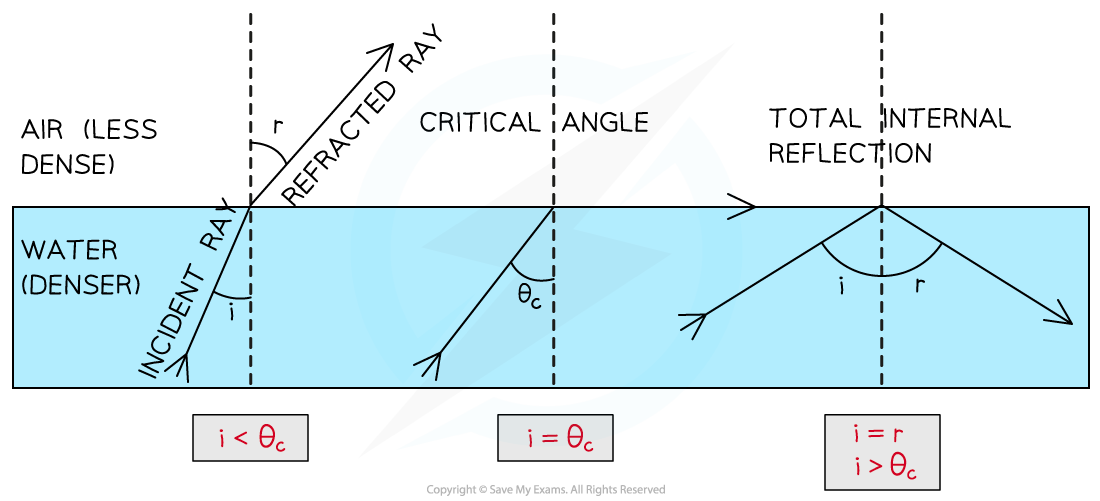
The critical angle is different for different materials. Refraction occurs when the angle of incidence is less than the critical angle, and total internal reflection occurs when it is greater
Total internal reflection is utilised in
optical fibres e.g. endoscopes
prisms e.g. periscopes
Optical fibres
Total internal reflection is used to reflect light along optical fibres, meaning they can be used for
communications
endoscopes
decorative lamps
Light travelling down an optical fibre is totally internally reflected each time it hits the edge of the fibre
Light travelling in an optical fibre

Optical fibres utilise total internal reflection for communications
Structure of an endoscope
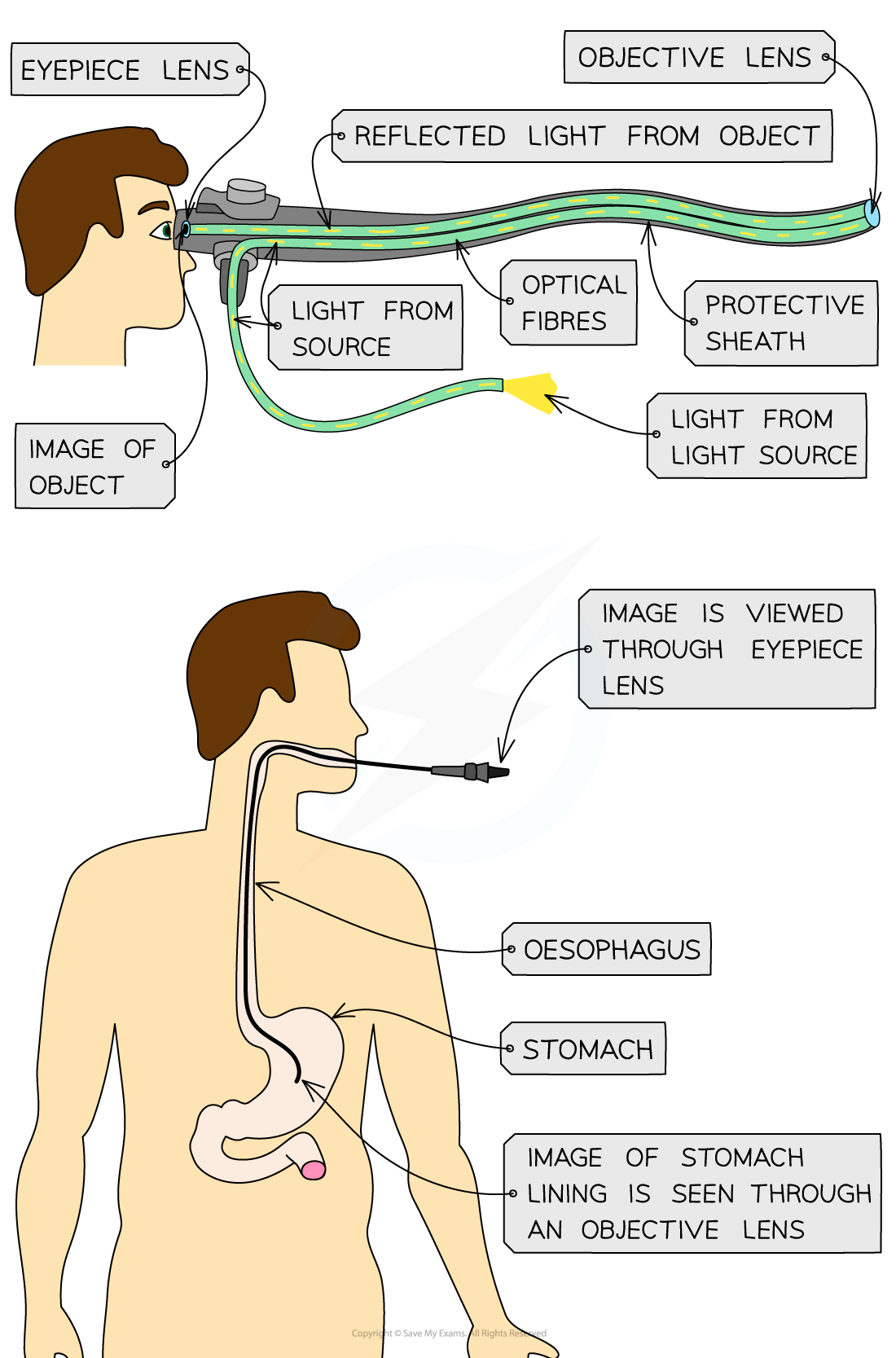
Endoscopes utilise total internal reflection to see inside a patient's body
Prisms
Prisms are used in a variety of optical instruments, including
periscopes
binoculars
telescopes
cameras
Prisms are also used in safety reflectors for bicycles and cars, as well as posts marking the edges of roads
A periscope is a device consisting of two right-angled prisms that can be used to see over tall objects
Reflection of light in a periscope
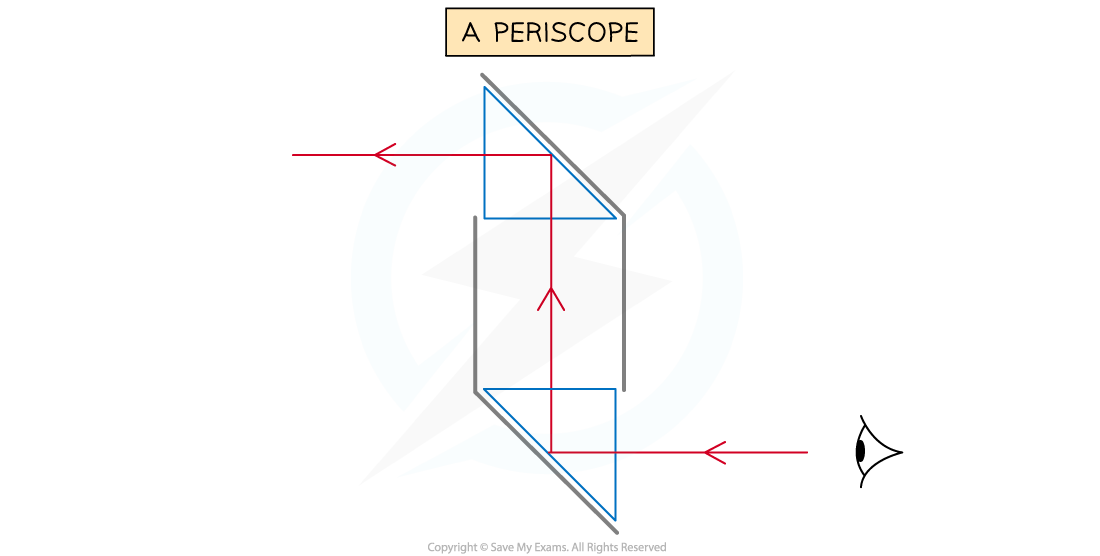
When light travels through a periscope, it totally internally reflects through prisms causing the light to reflect at right angles
The light totally internally reflects in both prisms
Reflection of light by right-angled prisms
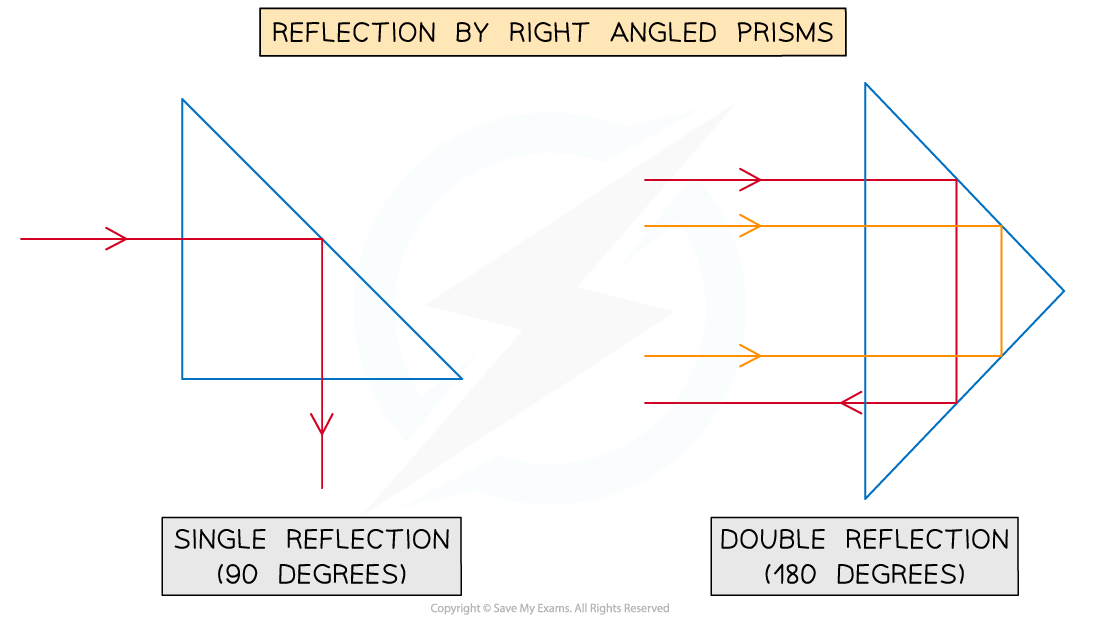
Single and double reflection through right-angled prisms
Examiner Tips and Tricks
If asked to name the phenomena make sure you give the whole name – total internal reflection.
Remember: total internal reflection occurs when going from a denser material to a less dense material and ALL of the light is reflected.
If asked to give an example of a use of total internal reflection, first state the name of the object that causes the reflection (e.g. a right-angled prism) and then name the device in which it is used (e.g. a periscope)
Critical angle
As the angle of incidence is increased, the angle of refraction also increases until it gets closer to 90°
When the angle of refraction is exactly 90° the light is refracted along the boundary
At this point, the angle of incidence is known as the critical angle c
Changing the angle of incidence to obtain the critical angle
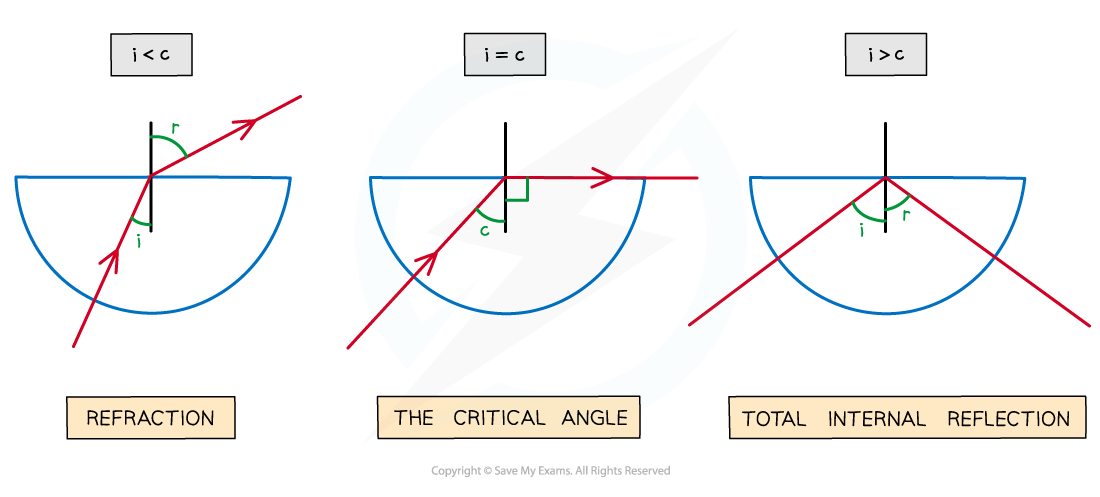
As the angle of incidence increases it will eventually surplus the critical angle and lead to total internal reflection of the light
When the angle of incidence is larger than the critical angle, the refracted ray is now reflected
This is total internal reflection
Worked Example
A glass cube is held in contact with a liquid and a light ray is directed at a vertical face of the cube. The angle of incidence at the vertical face is 39° and the angle of refraction is 25° as shown in the diagram.
The light ray is totally internally reflected for the first time at X.
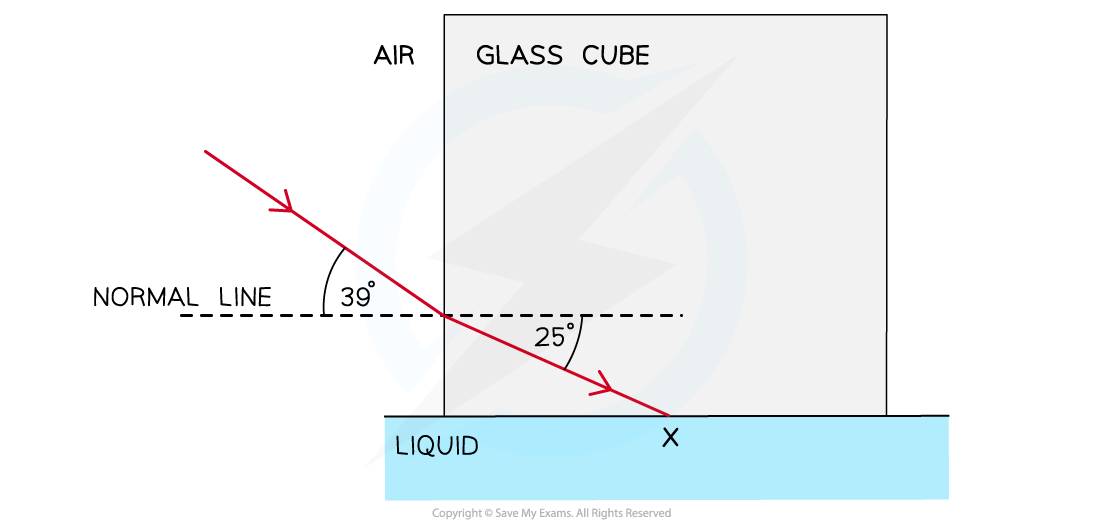
Complete the diagram to show the path of the ray beyond X to the air and calculate the critical angle for the glass-liquid boundary.
Answer:
Step 1: Draw the reflected angle at the glass-liquid boundary
When a light ray is reflected, the angle of incidence = angle of reflection
Therefore, the angle of incidence (or reflection) is 90° – 25° = 65°
Step 2: Draw the refracted angle at the glass-air boundary
At the glass-air boundary, the light ray refracts away from the normal
Due to the reflection, the light rays are symmetrical to the other side
Step 3: Calculate the critical angle
The question states the ray is “totally internally reflected for the first time” meaning that this is the lowest angle at which TIR occurs
Therefore, 65° is the critical angle
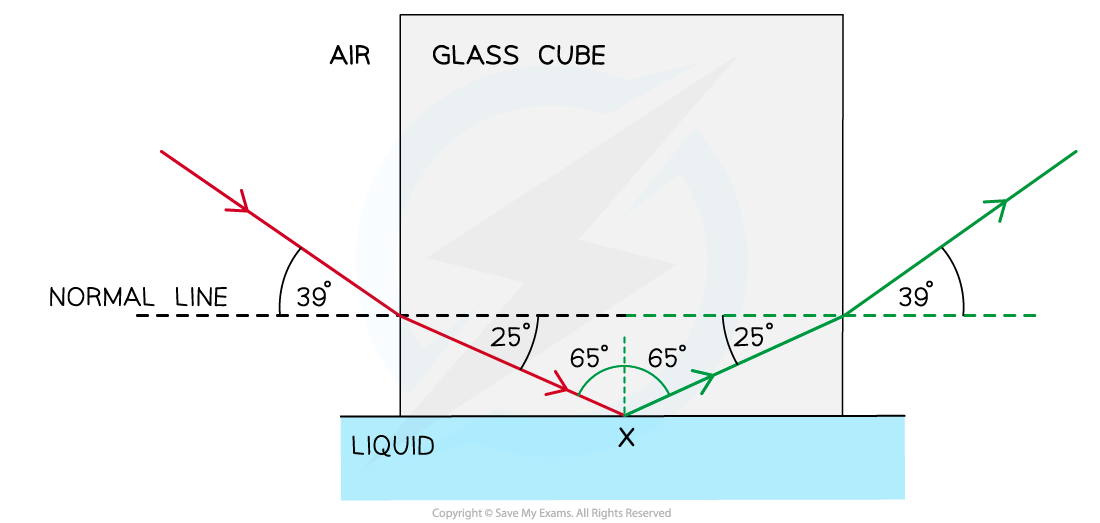
Examiner Tips and Tricks
If you are asked to explain what is meant by the critical angle in an exam, you can be sure to gain full marks by drawing and labelling the same diagram above (showing the three semi-circular blocks).
Calculating critical angle
The critical angle, c, of a material is related to its refractive index, n
The relationship between the two quantities is given by the equation:
This can also be rearranged to calculate the refractive index, n:
This equation shows that:
The larger the refractive index of a material, the smaller the critical angle
Light rays inside a material with a high refractive index are more likely to be totally internally reflected
Worked Example
Opals and diamonds are transparent stones used in jewellery. Jewellers shape the stones so that light is reflected inside. Compare the critical angles of opal and diamond and explain which stone would appear to sparkle more.
The refractive index of opal is about 1.5
The refractive index of diamond is about 2.4
Answer:
Step 1: List the known quantities
Refractive index of opal, no = 1.5
Refractive index of diamond, nd = 2.4
Step 2: Write out the equation relating critical angle and refractive index
Step 3: Calculate the critical angle of opal (co)
Step 4: Calculate the critical angle of diamond (cd)
Step 5: Compare the two values and write a conclusion
Total internal reflection occurs when the angle of incidence of light is larger than the critical angle (i>c)
In opal, total internal reflection will occur for angles of incidence between 42° and 90°
The critical angle of diamond is lower than the critical angle of opal (co>cd)
This means light rays will be totally internally reflected in diamond over a larger range of angles (25° to 90°)
Therefore, more total internal reflection will occur in diamond hence it will appear to sparkle more than the opal
Examiner Tips and Tricks
When calculating the value of the critical angle using the above equation:
First use the refractive index, n, to find sin(c)
Then use the inverse sin function (sin–1) to find the value of c

You've read 0 of your 5 free revision notes this week
Sign up now. It’s free!
Did this page help you?

